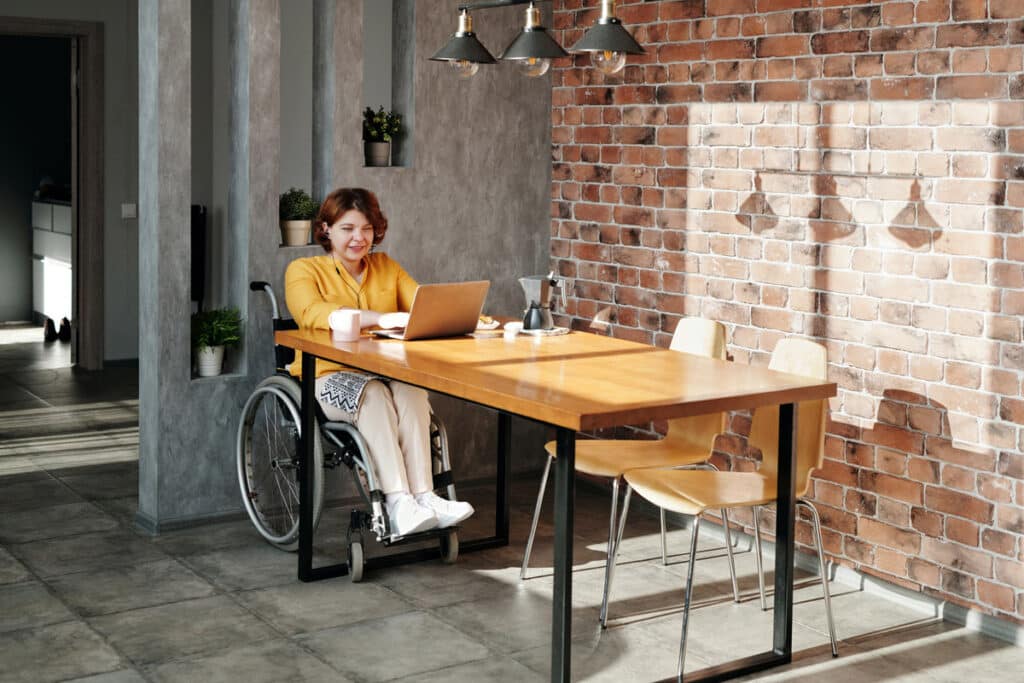Living with mobility issues can make everyday tasks, like bathing and walking up the stairs – very challenging. Unfortunately, many potential hazards around the home can make it difficult for people with mobility issues to be independent. However, that does not always have to be the case. There are plenty of helpful aids that can be used around the home to make it safe and comfortable for those with mobility issues. This guide will discuss nine of them in more detail.

Grab Rails
Grab rails are created using metal or plastic. They are a popular mobility aid that is usually fitted to doorways – and anywhere in the home that is a risk area for falls. There are many benefits to this useful aid. As previously mentioned, they minimise the risk of falls. They also provide extra support for people who struggle to get in and out of the bathroom. It empowers those with mobility aids by giving them improved independence. They are less likely to worry about how they will navigate throughout each room now they have support in place. If you would like to learn how to fix a grab rail, you can refer to some building forums online. There are plenty of tutorials that can help you.
Kitchen Utensils With Grips
Kitchen utensils are small and quite fiddly to hold at the best of times. For someone with mobility issues, it can be difficult to maintain a secure grip on them. Unfortunately, if someone with mobility issues drops their kitchen utensils on the floor, they would struggle to pick them up, which can be quite discouraging. Instead, it can be wise to invest in kitchen utensils that have grips. You can easily find these either online or in your local home store. The thoughtful design of grips on kitchen utensils makes everyday living easier, allowing people to use their hands with minimum strain. For example, someone with arthritis may have a weak grip, so finding utensils with a good grip is essential.
Raised Toilet Seats
Toilet seats can be quite low down, which is not helpful for someone with mobility problems. Although you can install grab rails beside the toilet to help people lift themselves up and down, it can also help to install a raised toilet seat. This makes the process of going to the bathroom a lot easier. For someone with mobility problems, it can give them peace of mind that they can visit the bathroom with ease. This improved independence means they no longer have to worry about how they will get to and from the toilet. You can purchase a raised toilet seat online or in some retail stores. The raised seat will replace the old toilet seat and fixes to the ceramic bowl. They are relatively easy to install.
Bariatric Profiling Beds
An electric profiling bed is an essential aid for those living with mobility issues. They are a type of adjustable bed that can be moved either manually or electronically to suit the needs of the person using it. For example, they are equipped with an adjustable backrest to help people sit up with ease. A bariatric profiling bed is a highly robust piece of equipment – suitable for all body weights. You can purchase one through organisations like the NHC Group. A bariatric profiling bed holds a significant volume of weight, so the person using it has peace of mind that they are supported as it is a highly sturdy device.
Commode
Although raised toilet seats offer people with mobility issues lots of benefits, a commode is another helpful resource to have. A commode is essentially a chamber pot concealed on a chair. They provide comfort and stability for those who need to use the toilet. They are particularly useful for people who struggle to navigate to the bathroom. The commode can be placed anywhere in the home, so it is always accessible. It is beneficial during the night, as someone with mobility issues will not have to walk through the house in the dark to get to the bathroom. It also helps caregivers – who may struggle to transfer their patients to the bathroom.
Slip Mats For The Bathroom
Unfortunately, the bathroom is an area of the home that is at high risk for slips, trips, and falls. Water can easily splash onto the floor when the sink or shower is in use. For someone with mobility issues, this can create a dangerous scenario. Luckily, slip mats can help. A slip mat is typically made from a material like rubber. It suctions onto hard surfaces to improve safety in the bathroom. They help minimise the risk of accidents on slippery surfaces. You can learn more about the benefits of slip mats by referring to some online research. The great thing about this mobility aid is that it can prevent injury – and is very cost-effective. You should be able to find a slip mat in your local home store.
Rest Stations
Some people with mobility issues still want the freedom to move around their homes. To help them do this safely, rest stations can be a good idea. A rest station doesn’t mean you have to fully reconstruct the house. Instead, you can place high-rise chairs around the home. So, when someone with limited mobility is walking from room to room, they can take the opportunity to sit down and have a rest if they feel it is necessary. It is also possible to purchase wall-mounted chairs for high-risk areas like the garden and the shower. This gives someone with mobility issues more independence and freedom to navigate their home safely.
Floor Lamps And Night Lights
Living with mobility issues already makes everyday living challenging. So, when you pair this with the dark, it can make life even harder. Therefore, floor lamps and night lights are essential. You will find that most homes have dark areas – that struggle to attract natural light. Brightening up these areas with lighting makes it easier for people to move around their homes. Not to mention, it also makes it a lot safer. Unfortunately, energy bills are rising, which may put some people off, leaving their lights on all day. However, there is a way around this. LED lights save a lot more energy than standard bulbs. You can find some of the best-LED lighting online or ask in your local home store.
Stair Lift
Stairs can be a challenge for anyone with limited mobility. Not to mention, they can be dangerous. A fall on the stairs could result in a severe injury. Rather than encouraging someone with limited mobility to use the stairs, consider installing a stair lift. There are two main types of stair lifts. Ones that travel up and down in a straight line and those that can curve around a staircase. The lift chair can also swivel around, making it easy for the person using it to get out of it. A stair lift is an expensive piece of equipment. However, your local council or housing association may be able to fund this for you. So, it is worth getting in touch with them – if you are worried about your finances.

